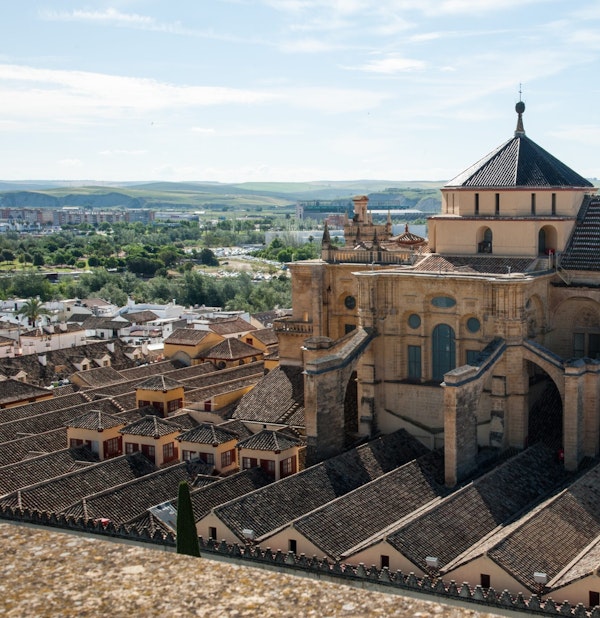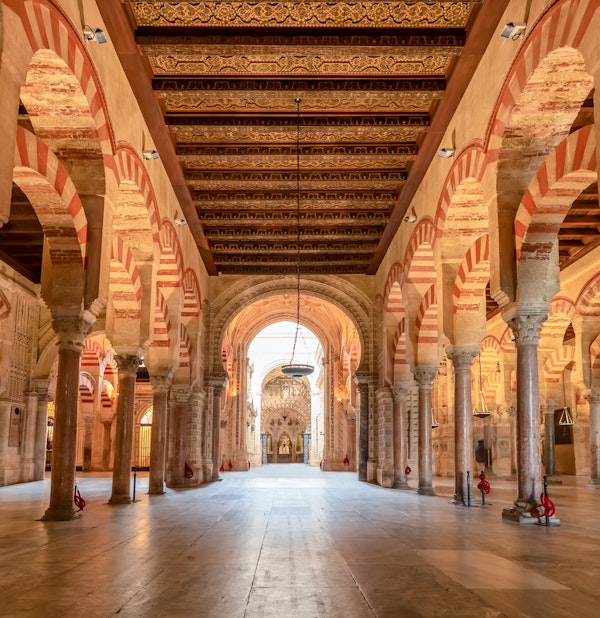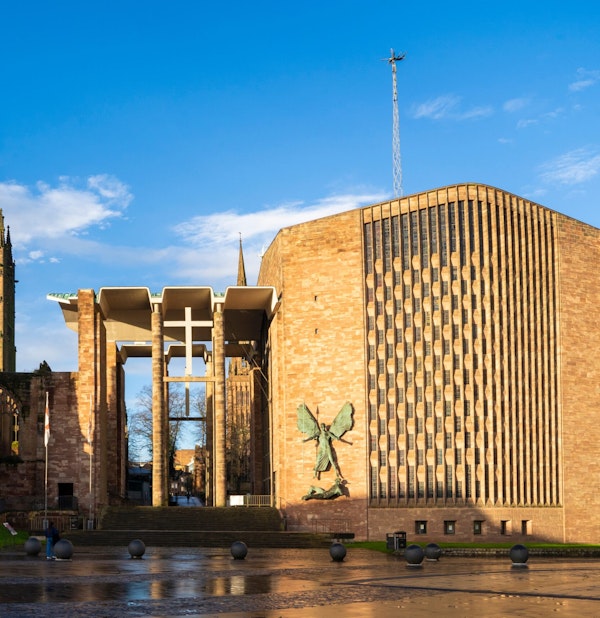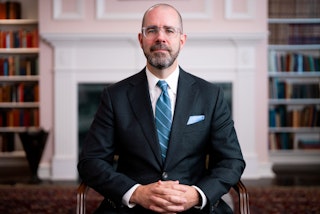The secret of sacred spaces
The mixed history of religious site reminds us that pluralism is always possible
 Aerial view of the bell tower of the Mezquita Mosque-Cathedral in Córdoba, Spain. (Sandra Moraes / Shutterstock)
Aerial view of the bell tower of the Mezquita Mosque-Cathedral in Córdoba, Spain. (Sandra Moraes / Shutterstock)
As a recent survey by the Pew Research Center documents, religious nationalism – the belief that a country’s dominant religion should help define its identity and its policies – is rising around the globe. Of course, religious nationalism is not a new phenomenon. Faith, identity, and political power have long been entangled. But the spike in such sentiment is dangerous, with the potential to spark or exacerbate conflicts around the world. Among the tools available to meet the challenge, sacred sites should not be overlooked, as they have unique potential to promote positive pluralism through dialogue. If deployed deliberately, sacred sites can help reverse negative trends by reminding members of different faiths of their own stories of diversity and cooperation – which can inspire understanding and peaceful pluralism today.
Shared ground
The Mezquita Mosque-Cathedral in Córdoba, Spain, offers a good example of the complicated histories of many religious sites, and how those complications can promote pluralism today. The building’s mix of Arab-Muslim and Christian motifs reveals its complex and layered history. Córdoba has been a site of worship for 1,500 years; some historians think a church existed on the grounds of the current complex as far back as the mid-sixth century, when the Visigoths ruled the territory. In A.D. 711, North African Arab and Berber forces loyal to the Umayyad dynasty in Damascus crossed the Strait of Gibraltar and conquered much of the Iberian Peninsula in a series of quick victories. In 786, Abd al-Rahman I, the first emir of al-Andalus, constructed a mosque in Córdoba where the original Visigoth church once stood. That mosque would continue to be developed over the next 300 years as the Caliphate of Córdoba expanded.
In 1146, a Christian army reconquered the city. Under King Fernando III, a small chapel was inserted into the center of the complex and the entire space was consecrated for Christian worship. Yet few alterations were made to the rest of the structure. In the 16th century, the Bishop of Córdoba announced plans to raze the mosque and build a new cathedral in its place. The town council of Córdoba vehemently objected because of the mosque’s uniqueness and its connection to the city’s history, launching a protest that ultimately reached Emperor Charles V. The emperor responded by directing that the cathedral be placed in the middle of the preexisting structure. In the ensuing years, an ornate Baroque church, the Catholic Cathedral of Our Lady of the Assumption, arose amidst the complex, and the mosque’s minaret was covered with a new façade to turn it into a bell tower.
Today, the Mezquita Mosque-Cathedral is a place unlike any other, blending Arab-Muslim and European-Christian influences and architecture, along with pagan Roman and Visigothic pillars and cornices. When the author visited at the start of Holy Week (Semana Santa) in April, the church was preparing for Easter services. Yet visitors from many different cultures, faiths, and backgrounds peacefully wandered through the beautiful complex.
 Interior of the Mezquita Mosque-Cathedral in Córdoba, Spain. (Agsaz / Shutterstock)
Interior of the Mezquita Mosque-Cathedral in Córdoba, Spain. (Agsaz / Shutterstock)
Contested spaces
The Mezquita’s history typifies how throughout history, conquerors have flexed their power over the conquered. In premodern civilizations, religious nationalism was the norm, since distinctions between faith, nationality, and the state did not yet exist. Political bodies – kingdoms and empires – derived their legitimacy from divine authority. Thus when kingdoms fell, new rulers reconfigured their places of worship to reflect their own beliefs. That’s what occurred multiple times in Córdoba. And something similar took place centuries later in Constantinople’s Hagia Sophia Cathedral, after the city fell to Ottoman forces who converted the church into a mosque. In a similar vein, after the Mughals conquered India, they constructed the Babri Mosque in 1529 on the very site where Hindu devotees believe Lord Ram was born.
Today, these three sites are used in very different ways, highlighting the obstacles that still exist to transform places once used to divide into those that promote pluralism. In recent years, populist politicians in both Turkey and India have exploited religious nationalism by appropriating symbolic sites for their own narrow purposes. In 2019, India’s supreme court (at the urging of Prime Minister Narendra Modi) ruled that a temple to Ram could be built on the grounds of the Babri Mosque; when the temple was completed last year, Modi attended its inauguration. In 2020, Turkish President Recep Tayyip Erdogan transformed the Hagia Sophia (which had been a museum since 1935) back into a mosque. In each case, the leaders in question exploited the sites to score political points against their opponents, real or perceived. The concerns of minority populations were ignored.
The Mezquita has not been immune from these debates; over the years, there have been many arguments over its status and functionality. Should it be used solely as a place of restored Catholic worship or be open to ecumenical prayers, in order to represent convivencia (Spanish for “living together”) and emphasize the region’s multicultural past?
In the internet age, what happens in one place can resonate around the world. Roughly a decade ago, the so-called Islamic State called for a reconquest of Spain and the reconversion of the Mezquita into a mosque. And when the Hagia Sophia was turned back into a mosque, some advocates defended the move in Turkey by pointing out that the Mezquita remains a church. Foreign players – including Pakistan and the Organization of Islamic Cooperation – also weighed in on India’s construction of the Ram Temple, critiquing the court ruling.
 Coventry Cathedral in Coventry, England. (Pauline Mongary / Shutterstock)
Coventry Cathedral in Coventry, England. (Pauline Mongary / Shutterstock)
Making sacred sites work
As the above suggests, sacred sites can be manipulated in ways that divide people along religious nationalist lines. The complex histories of sites such as the Mesquita, the Hagia Sophia, and the Ram Temple/Babri Mosque, however, also offer a unique opportunity to foster positive conversations about history and diversity. Because of their fraught past, these places provide an incomparable venue to launch conversations about living together today.
The key to making such conversations work is to ensure that members of different communities get to share their views about the complex in question, its past, and interfaith relations today. Such discussions should focus not on ownership or prayer rights (or rites), but on creating a covenant to promote peaceful pluralism. Research conducted by my program (the Program on Global Faith and Inclusive Societies at Pepperdine University) has shown that sacred sites have great potential as an overlooked method for promoting neighborly solidarity among people from different backgrounds and beliefs – and to do so in a way that builds a local narrative that supports pluralism and inclusion.
With the proper stewardship, sacred spaces can become a point of intersection between people of different backgrounds and beliefs, bringing communities together and inoculating them against the virus of religious nationalism. Our research has documented the way several organizations around the world are producing such results. Their different approaches demonstrate the flexibility sacred sites provide to advance peaceful pluralism in a locally relevant, acceptable, and sustainable way.
Consider, for example, a U.S. organization called Sharing Sacred Spaces. The group’s Interreligious Communities Project has held training sessions across the country, including in the Dallas area, where (according to the organizers) participants “visit one another’s sacred spaces, extend hospitality, equip ourselves with tools for dialogue, and build an interfaith citywide community.” Using the physical environment as an educational tool, the training sessions immerse people from different backgrounds in sacred spaces they have not encountered before. This volunteer-driven, grassroots effort encourages new relationships.
At the other end of the spectrum is Coventry Cathedral in the United Kingdom, which was destroyed during World War II by German bombs. In the decades since, the cathedral’s leadership has recognized the spiritual dimension of reconciliation work and the example of forgiveness the church ruins powerfully provide. When colleagues and I visited to research the site, the Very Rev. John Witcombe, dean of the cathedral, explained that they are “healing the wounds of history through the convening ability of the destroyed cathedral.” Such efforts range from the local to the international. The cathedral has hosted community members from different faith backgrounds to discuss living together in a multicultural society and convened interfaith peace efforts between Sunni and Shia Muslims in Iraq. My colleagues and I experienced firsthand the profound impact the ruins, still standing as a shell, can have.
New sites can also perform important functions. The Abrahamic Family House (AFH) in Abu Dhabi, which opened in 2023, contains sacred spaces for Muslim, Christian, and Jewish worship – the only such multifaith space on the Arabian Peninsula. Abdulla Al Shehhi, executive director of the AFH, explains how he and his colleagues take advantage of the colocated sacred sites to spark conversations about living together in diversity. In a November 2024 interview at the U.S. Institute of Peace, he described how the site’s imam, priest, and rabbi “engage with each other, learn from each other, and also teach their respective communities every day.” The shared site provides a physical opportunity for them to model “promoting peace and bringing people together.”
Education is also an essential means of inoculating young people against religious nationalism. In Indonesia, the Leimena Institute, through its Cross-Cultural Religious Literacy program, encourages Muslim and Christian students to visit each other’s religious schools to demystify them and build common understanding. These visits improve religious literacy and cross-cultural skills while promoting living together.
Together, these different types of engagement demonstrate how sacred sites can be used to cultivate peaceful pluralism. Such spaces represent an overlooked opportunity to address pressing problems. Engaging historic sacred sites with contested narratives will take courage, especially as religious nationalists strive to manipulate those sites for political gain. With the proper perspective and leadership, however, sacred sites can provide space for dialogue. If managed in good faith, their contested histories can spark constructive conversations about living together in diversity.
The Catalyst believes that ideas matter. We aim to stimulate debate on the most important issues of the day, featuring a range of arguments that are constructive, high-minded, and share our core values of freedom, opportunity, accountability, and compassion. To that end, we seek out ideas that may challenge us, and the authors’ views presented here are their own; The Catalyst does not endorse any particular policy, politician, or party.

